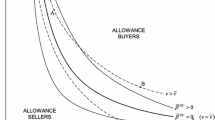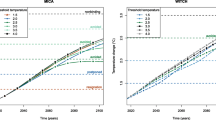Abstract
We present two solution algorithms for a large-scale integrated assessment model of climate change mitigation: the well known Negishi algorithm and a newly developed Nash algorithm. The algorithms are used to calculate the Pareto-optimum and competitive equilibrium, respectively, for the global model that includes trade in a number of goods as an interaction between regions. We demonstrate that in the absence of externalities both algorithms deliver the same solution. The Nash algorithm is computationally much more effective, and scales more favorably with the number of regions. In the presence of externalities between regions the two solutions differ, which we demonstrate by the inclusion of global spillovers from learning-by-doing in the energy sector. The non-cooperative treatment of the spillover externality in the Nash algorithm leads to a delay in the expansion of renewable energy installations compared to the cooperative solution derived using the Negishi algorithm.








Similar content being viewed by others
Notes
Within an iterative sequence (Nordhaus and Yang 1996) compute a closed-loop Nash equilibrium (Fudenberg and Levine 1988). Technically, this is an outcome of a finite game with perfect information and calculated through backward induction (Mas-Colell et al. 1995, Chapter 9; Kicsiny et al. 2014). A survey on Generalized Nash equilibrium problems is provided by Facchinei and Kanzow (2010). Yang (2003) demonstrated how the closed-loop solution can be found by a computationally more tractable sequence of open-loop equilibria.
We solve the model on a high-performance computer cluster equipped with Intel Xeon E5472 CPUs at 3.0 GHz.
References
Arrow, K. J., & Hahn, F. H. (1971). General competitive analysis. Mathematical Economic Texts (Vol. 6, p. 452). San Francisco: Oliver and Boyd.
Bauer, N., Edenhofer, O., & Kypreos, S. (2008). Linking energy system and macroeconomic growth models. Journal of Computational Management Science, 5, 95–117.
Bosetti, V., Carraro, C., Massetti, E., & Tavoni, M. (2006). WITCH A world induced technical change hybrid model. The Energy Journal, 27, (Special Issue: Hybrid modeling of energy-environment policies reconciling bottom-up and top-down), 13–37.
Bosetti, V., Carraro, C., Galeotti, M., Massetti, E., & Tavoni, M. (2008). International energy R&D spillovers and the economics of greenhouse gas atmospheric stabilization. Energy Economics, 30, 2912–2929.
Brechet, T., Camacho, C., & Veliov, V. M. (2014). Model predictive control, the economy, and the issue of global warming. Annals of Operations Research, 220, 25–48.
Brooke, A., Kendrick, D., & Meeraus, A. (1992). GAMS—A user’s guide, release 2.25. San Francisco: The Scientific Press.
Clarke, L., Jiang, K., et al. (2014). Assessing transformation pathways. In Climate change 2014—Mitigation of climate change, working group III contribution to the fifth assessment report of the intergovernmental panel on climate change, chapter 6.
Copeland, B. R., & Taylor, M. S. (2005). Free trade and global warming: A trade theory view of the Kyoto protocol. Journal of Environmental Economics and Management, 49, 205–234.
Crassous, R., Hourcade, J.-C., & Sassi, O. (2006). Endogenous structural change and climate targets, modelling experiments with Imaclim-R. The Energy Journal, 27, (Special Issue: Endogenous technological change and the economics of atmospheric stabilisation), 259–276.
Dixon, P. B. (1975). The theory of joint maximization. Amsterdam: North-Holland Publishing Company.
Drud, A. (1994). CONOPT—A large-scale GRG code. ORSA Journal on Computing, 6, 207–216.
Facchinei, F., & Kanzow, C. (2010). Generalized Nash equilibrium problems. Annals of Operations Research, 175, 177–211.
Finus, M., Rundshagen, B., & Eyckmans, J. (2014). Simulating a sequential coalition formation process for the climate change problem: First come, but second served? Annals of Operations Research, 220, 5–23.
Fudenberg, D., & Levine, K. L. (1988). Open-loop and closed-loop equilibria in dynamic games with many players. Journal of Economic Theory, 44, 1–18.
Huebler, M., Baumstark, L., Leimbach, M., Bauer, N., & Edenhofer, O. (2012). An integrated assessment model with endogenous growth. Ecological Economics, 83, 118–131.
Kicsiny, R., Varga, Z., & Scarelli, A. (2014). Backward induction for a class of closed-loop Stackelberg games. European Journal of Operational Research, 237, 1021–1036.
Leimbach, M., & Baumstark, L. (2010). The impact of capital trade and technological spillovers on climate policies. Ecological Economics, 69, 2341–2355.
Leimbach, M., Bauer, N., Baumstark, L., & Edenhofer, O. (2010). Mitigation costs in a globalized world: Climate policy analysis with REMIND-R. Environmental Modeling and Assessment, 15, 155–173.
Leimbach, M., Baumstark, L., & Luderer, G. (2015). The role of time prefences in explaining the long-term pattern of international trade. Global Economy Journal, 15, 83–106. doi:10.1515/gej-2014-0035.
Luderer, G., Leimbach, M., Bauer, N., Kriegler, E., Baumstark, L., Bertram, C., Giannousakis, A., Hilaire, J., Klein, D., Levesque, A., Mouratiadou, I., Pehl, M., Pietzcker, R., Piontek, F., Roming, N., Schultes, A., Schwanitz, V. J., & Strefler, J. (2015). Description of the REMIND Model (Version 1.6) (November 30, 2015). Available at SSRN: http://ssrn.com/abstract=2697070
Magne, B., Kypreos, S., & Turton, H. (2010). Technology options for low stabilization pathways with MERGE. The Energy Journal, 31, 83–107.
Mandel, A., & Gintis, H. (2016). Decentralized Pricing and the equivalence between Nash and Walrasian equilibrium. Journal of Mathematical Economics, 63, 84–92.
Manne, A. S., Mendelsohn, M., & Richels, R. (1995). MERGE—A model for evaluating regional and global effects of GHG reduction policies. Energy Policy, 23, 17–34.
Manne, A. S., & Richels, R. (2004). The impact of learning-by-doing on the timing and costs of CO\(_2\) abatement. Energy Economics, 26, 603–619.
Manne, A. S., & Rutherford, T. (1994). International trade, capital flows and sectoral analysis: Formulation and solution of intertemporal equilibrium models. In W. W. Cooper & A. B. Whinston (Eds.), New directions in computational economics (pp. 191–205). Dordrecht: Kluwer Academic Publishers.
Mas-Colell, A., Whinston, M. D., & Green, J. R. (1995). Microeconomic theory. New York: Oxford University Press.
Meinshausen, M., Raper, S. C. B., & Wigley, T. M. L. (2011). Emulating coupled atmosphere-ocean and carbon cycle models with a simpler model, MAGICC6. Part 1: Model description and calibration. Atmospheric Chemistry and Physics, 11, 1417–1456. doi:10.5194/acp-11-1417-2011.
Messner, S., & Schrattenholzer, L. (2000). MESSAGE-MACRO: Linking an energy supply sodel with a macroeconomic module and solving it iteratively. Energy, 25, 267–282.
Negishi, T. (1972). General equilibrium theory and international trade. Amsterdam: North-Holland.
Nordhaus, W. D., & Boyer, J. (2000). Warming the world: Economic models of global warming. Cambridge, MA: MIT Press.
Nordhaus, W. D., & Yang, Z. (1996). A regional dynamic general-equilibrium model of alternative climate-change strategies. American Economic Review, 86, 741–765.
Pan, V. (1992). Complexity of computation with matrices and polynomials. SIAM Review, 34, 225–262.
Rao, S., Peppo, I., & Riahi, K. (2006). Importance of technological change and spillovers in long-term climate policy. The Energy Journal, 27, (Special Issue: Endogenous technological change and the economics of atmospheric stabilisation), 123–139.
Rogelj, J., Hare, W., Lowe, J., van Vuuren, D. P., et al. (2011). Emission pathways consistent with a \(2\,^{\circ } \text{ C }\) global temperature limit. Nature Climate Change, 1, 413–418.
Scarf, H. (1967). On the computation of equilibrium prices. In W. Fellner (Ed.), Ten economic studies in the tradition of irving fisher (pp. 207–230). New York: Wiley.
Yang, Z. (2003). Reevaluation and renegotation of climate change coalitions—A sequential closed-loop game. Journal of Economic Dynamics & Control, 27, 1563–1594.
Weber, C. L., & Peters, G. P. (2009). Climate change policy and international trade: Policy considerations in the US. Energy Policy, 37, 432–440.
Weyant, J., Davidson, O., Dowlabathi, H., Edmonds, J., Grubb, M., Parson, E. A., et al. (1996). Integrated assessment of climate change: An overview and comparison of approaches and results. In J. P. Bruce, et al. (Eds.), Climate change 1995: Economic and social dimensions of climate change (pp. 367–439). Cambridge: Cambridge University Press.
Acknowledgments
Funding from the German Federal Ministry of Education and Research (BMBF) in the Call Economics of Climate Change (funding code 01LA1105A CliPoN) is gratefully acknowledged.
Author information
Authors and Affiliations
Corresponding author
Additional information
Marian Leimbach and Anselm Schultes have contributed equally to this study.
Rights and permissions
About this article
Cite this article
Leimbach, M., Schultes, A., Baumstark, L. et al. Solution algorithms for regional interactions in large-scale integrated assessment models of climate change. Ann Oper Res 255, 29–45 (2017). https://doi.org/10.1007/s10479-016-2340-z
Published:
Issue Date:
DOI: https://doi.org/10.1007/s10479-016-2340-z




